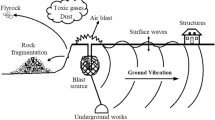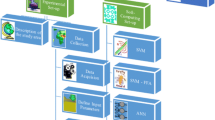Abstract
Genetic algorithm (GA) and support vector machine (SVM) optimization techniques are applied widely in the area of geophysics, civil, biology, mining, and geo-mechanics. Due to its versatility, it is being applied widely in almost every field of engineering. In this paper, the important features of GA and SVM are discussed as well as prediction of longitudinal wave velocity and its advantages over other conventional prediction methods. Longitudinal wave measurement is an indicator of peak particle velocity (PPV) during blasting and is an important parameter to be determined to minimize the damage caused by ground vibrations. The dynamic wave velocity and physico-mechanical properties of rock significantly affect the fracture propagation in rock. GA and SVM models are designed to predict the longitudinal wave velocity induced by ground vibrations. Chaos optimization algorithm has been used in SVM to find the optimal parameters of the model to increase the learning and prediction efficiency. GA model also has been developed and has used an objective function to be minimized. A parametric study for selecting the optimized parameters of GA model was done to select the best value. The mean absolute percentage error for the predicted wave velocity (V) value has been found to be the least (0.258 %) for GA as compared to values obtained by multivariate regression analysis (MVRA), artificial neural network (ANN), adaptive neuro-fuzzy inference system (ANFIS), and SVM.













Similar content being viewed by others
References
Aveline M (1964) Experimental results on the relation between micro-fissuration and speed of propagation of ultrasounds in the granites of Sidbore. Sci Terre 9(4):439–448
Berezkin V M & Mikhaylov I N 1964 On the correlational relationship between the density of rocks and their velocities of elastic wave propagation for the central and eastern regions of Russian platform, Geofiz, Razvedka. 16, 83-91
Boadu FK (1997) Fractured rock mass characterization parameters and seismic properties: analytical studies. J Appl Geophys 36:1–19
Chiu S (1994) Fuzzy model identification based on cluster estimation. J Intelli and Fuzzy Systs 2(3):267–278
Das SK, Basudhar PK (2007) “Prediction of Hydraulic Conductivity of Clay Liners Using Artificial Neural Network” Low land Technology International Journal, Japan, June
Das SK, Samui P, Sabat AK (2011) Application of artificial intelligence to maximum dry density and unconfined compressive strength of cement stabilized soil. Geotech Geol Eng 29(3), 329--342
Goodman RE (1989) Introduction to rock mechanics, 2nd edn. Wiley, New York, p 562
Hogstrom K (1994) A study on strength parameter for aggregate from south western Sweden rocks, Res Rep. Chamer Univ of Technology, Goteborg, Sweden, pp 123–134
Hudson TA, Jones ETW, New BM (1980) P-wave velocity measurements in a machine bored chalk tunnels. Q J Eng Geol 13:33–43
Karpuz C, Pasamehmetoglu AG (1997) Field characterization of weathered Ankara andesites. Eng Geol 46:1–17
Kern H (1990) Laboratory seismic measurements: an aid in the interpretation of seismic field data. Terra Nov. 2:203–617
Khandelwal M, Singh TN (2006) Prediction of blast induced ground vibrations and frequency in opencast mine: a neural network approach. J Sound Vib 289(4):711–725
Monjezi M, Dehghani H (2008) Evaluation of effect of blasting pattern parameters on back break using neural networks. Int Jol of Rock Mech and Mining Sci 45(8):1446–1453
Nian T, D. Zheng (2006) Application of a simple genetic algorithm to the stability of slopes subjected to pore-water pressure, in: Proceedings of 6th World Congress on Intelligent Control and Automation, Dalian, China, pp. 3668–3671
Price DG, Malone AW, Knill TL (1970) The application of seismic methods in the design of rock bolt system. Proc. 1st Int. Congr. Int Assoc Eng Geol 2:740–752
Richard MD, Lippmann RP (1991) Neural network classifiers estimate Bayesian a posteriori probabilities. Neural Comput 3(4):461–483
Sabat AK (2015) “Prediction of Maximum Dry Density and Specific Gravity of Fly Ash using Support Vector Machine,” Electron J Geotech Eng 20(1):155--166
Sengupta A, Upadhyay. A (2009) locating the critical failure surface in a slope stability analysis by genetic algorithm, Applied Soft Computing, (2009) 387–392
Sinha S, Singh TN, Singh VK, Verma AK (2010) Epoch determination for neural network by self-organized map (SOM). Comput Geosci 14(1):199–206
Singh TN, Kanchan R, Verma AK (2004a) Prediction of blast induced ground vibration and frequency using an artificial intelligence technique. Int J Noise Vib Worldw, Multi Sci Pub UK 35(11):7–14
Singh TN, Verma AK (2005) Prediction of creep characteristic of rock under varying environment. Environ Geol 48(4):559–568
Singh TN, Kanchan R, Saigal K, Verma AK (2004b) Prediction of P-wave velocity and anisotropic properties of rock using artificial neural networks technique. J Sci Ind Res, CSIR Publ 63(1):32–38
Takagi T, Sugeno M (1985) Fuzzy identification of systems and its applications to modeling and control. IEEE Trans Syst, Man, Cybern SMC-15(1):116–132
Vakil-Baghmisheh M, Mansour P, Sadeghi MH, Ettefagh MM (2008) Crack detection in beam-like structures using genetic algorithms. J Appl Soft Comput 8(2):1150–1160
Vapnik V (1995) The nature of statistical learning theory. Springer, New York
Vapnik V, Lerner A (1963) Pattern recognition using generalized portrait method. Autom Remote Control 24:774–780
Vapnik VN, Chervonenkis AY (1991) The necessary and sufficient conditions for consistency in the empirical risk minimization method. Pattern Recogni Image Anal 1(3):283–305
Verma AK, Singh TN (2009) A neuro-genetic approach for prediction of compressional wave velocity of rock and its sensitivity analysis. Int Jof Earth Sci and Engg 2(2):81–94
Young RP, Hill TT, Bryan IR, Middleton R (1985) Seismic spectroscopy in fracture characterization. Q J Eng Geol 18:59–479
Yudborovsky I and Vilenskaya S M 1962 Some results of study of the elastic properties of rocks of western central Asia; Akad Nauk Turkmen SSR Ser Fiz-Tekh Khim Geol Nauk. 3, 26-31
Author information
Authors and Affiliations
Corresponding author
Rights and permissions
About this article
Cite this article
Singh, J., Verma, A.K., Banka, H. et al. A study of soft computing models for prediction of longitudinal wave velocity. Arab J Geosci 9, 224 (2016). https://doi.org/10.1007/s12517-015-2115-x
Received:
Accepted:
Published:
DOI: https://doi.org/10.1007/s12517-015-2115-x




